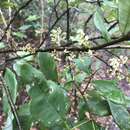en
names in breadcrumbs


Guioa is a genus of about 78 rainforest tree species known to science, which constitute part of the plant family Sapindaceae.[1][2] They have a wide distribution, ranging from throughout Malesia, in Burma, Cambodia, Vietnam, Thailand, Malay Peninsula, Borneo, Sumatra, Philippines, Java, Flores, Timor, Sulawesi, Moluccas, New Guinea, further southwards through the east coast of Queensland and New South Wales, Australia and further eastwards to the Pacific Islands, including Tonga, New Caledonia, Fiji and Samoa.[2][3][4]
At global, national and regional government scales, many Guioa species have been threatened with extinction, as officially recognised by the International Union for Conservation of Nature (IUCN) and by continental, national and local governments. Twenty five species, or more, have official IUCN global conservation statuses of either "critically endangered", "endangered" or "vulnerable" (to global extinction).
The Australian species are known to the logging industry as cedars, though they have no direct relationship with true cedars or the Australian members of the Meliaceae which are known as cedars.
This incomplete listing was sourced from Peter C. van Welzen's 1989 revision of the genus[1] and earlier scientific papers,[5] the Australian Plant Name Index and Australian Plant Census,[2] the Census of Vascular Plants of Papua New Guinea,[3] Flora Malesiana,[4] the Checklist of the vascular indigenous Flora of New Caledonia,[6] Flora Vitiensis (Fiji),[7] and the Flora of Tonga.[8]
Guioa is a genus of about 78 rainforest tree species known to science, which constitute part of the plant family Sapindaceae. They have a wide distribution, ranging from throughout Malesia, in Burma, Cambodia, Vietnam, Thailand, Malay Peninsula, Borneo, Sumatra, Philippines, Java, Flores, Timor, Sulawesi, Moluccas, New Guinea, further southwards through the east coast of Queensland and New South Wales, Australia and further eastwards to the Pacific Islands, including Tonga, New Caledonia, Fiji and Samoa.
At global, national and regional government scales, many Guioa species have been threatened with extinction, as officially recognised by the International Union for Conservation of Nature (IUCN) and by continental, national and local governments. Twenty five species, or more, have official IUCN global conservation statuses of either "critically endangered", "endangered" or "vulnerable" (to global extinction).
The Australian species are known to the logging industry as cedars, though they have no direct relationship with true cedars or the Australian members of the Meliaceae which are known as cedars.